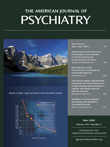Cortical Serotonin 5-HT 2A Receptor Binding and Social Communication in Adults With Asperger’s Syndrome: An in Vivo SPECT Study
Abstract
Objective: The cause of autistic spectrum disorder (i.e., autism and Asperger’s syndrome) is unknown. The serotonergic (5-HT) system may be especially implicated. However, cortical 5-HT 2A receptor density in adults with the disorder has not been examined, to the authors’ knowledge. Method: The authors investigated cortical 5-HT 2A receptor binding in eight adults with Asperger’s syndrome and in 10 healthy comparison subjects with single photon emission computed tomography and the selective 5-HT 2A receptor ligand 123I iodinated 4-amino-N-[1-[3-(4-fluorophenoxy)propyl]-4-methyl-4-piperidinyl]-5-iodo-2-methoxybenzamide ( 123 I-5-I-R91150). Results: People with Asperger’s syndrome had a significant reduction in cortical 5-HT 2A receptor binding in the total, anterior, and posterior cingulate; bilaterally in the frontal and superior temporal lobes; and in the left parietal lobe. Also, reduced receptor binding was significantly related to abnormal social communication. Conclusions: The authors’ findings suggest that adults with Asperger’s syndrome have abnormalities in cortical 5-HT 2A receptor density and that this deficit may underlie some clinical symptoms.



